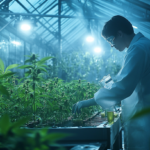While marijuana is known to cause few side effects, synthetic marijuana is far more dangerous.
The prohibition of marijuana has produced many unforeseen consequences. Scientific research, medicine, and job opportunities have all been stifled by the lasting effects of the War on Drugs. Unfortunately, outlawing marijuana has also led to the proliferation of synthetic marijuana use.
Synthetic marijuana mimics cannabinoids and interacts with brain receptors in the endocannabinoid system. One of the most recognized synthetic cannabinoids, JWH-018, derives its initials from John W. Huffman, the Clemson University chemist who created the compound. Huffman was funded to research cannabinoid receptors in the brain by the National Institute on Drug Abuse. He examined the bonds created between synthetic compounds such as JWH-018 and the endocannabinoid system. In 1993, Huffman published the formula for JWH-018 in a series of papers called “The Cannabinoid Receptors.” It was never his intention to be considered the godfather of synthetic marijuana, but his formula has served as the blueprint for black market chemists.
The U.S. Centers for Disease Control just released a new study examining synthetic marijuana use. The study found that teens who use synthetic pot have an increased risk of violence and unprotected sex and a higher potential for drug addiction.
“The findings indicate that students who report using synthetic marijuana are possibly on a very concerning health trajectory, which is particularly serious given that synthetic marijuana use is relatively common among adolescents,” said lead researcher Heather Clayton.
Jwh-018 has been banned by federal authorities. Unfortunately, the market has been able to stay one step ahead when creating synthetic marijuana products. Chemists simply alter the compound slightly, and then technically they are no longer using the banned compound. Instead, they are using a new compound that has yet to be discovered and added to the list of banned substances.
Because of this “workaround,” products such as K2 and Spice keep creeping onto convenience store shelves. Technically they are not illegal, nor are they regulated. This makes teen access easier than it is for other controlled substances such as alcohol.
Dr. Scott Krakower is the assistant unit chief of psychiatry at Zucker Hillside Hospital in Glen Oaks, N.Y. He is alarmed by how quick black market chemists can alter synthetic compounds. “They are coming out with agents almost faster than we can detect them. Parents should monitor their children closely, especially if their child has already been using marijuana,” he said.
Last July, 33 Brooklyn residents were hospitalized after overdosing on synthetic marijuana. They were described as behaving like zombies, by witnesses. There are dozens of other similar stories.
It is hard to see a demand for dangerous synthetics if marijuana had not been outlawed and demonized for a century. Alcohol prohibition created the mob, but it looks like marijuana prohibition created an altogether different monster, one that we have no answers for right now.











